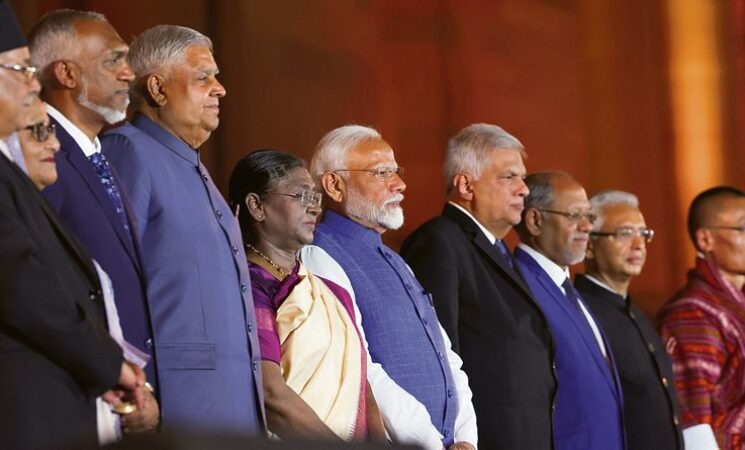1 October 2024, NIICE Commentary 9632
Syed Ali Abbas & Amna Saqib
In recent years, India has sought to assert itself as the dominant power in South Asia, leveraging its influence over smaller neighboring states. Under Prime Minister Narendra Modi, India has adopted a proactive and often interventionist foreign policy. However, the recent political upheaval in Bangladesh, marked by the resignation of Prime Minister Sheikh Hasina, has revealed the limitations of New Delhi’s influence. Despite India’s efforts to support Hasina, the unfolding events in Bangladesh highlight the fact that India’s control over political dynamics in its neighborhood is far from absolute.
India’s Ascent Under Modi
Since Narendra Modi assumed office in 2014, India has actively worked to solidify its role as the leading power in South Asia. This ambition is reflected in its foreign policy that often involves direct engagement in the internal affairs of neighboring countries. By supporting friendly regimes and leveraging its economic and military clout, India has managed to shape the political landscapes of several South Asian states, asserting its influence across the region.
India’s influence in Bangladesh has been particularly strong. Since 2009, Prime Minister Sheikh Hasina, developed a close relationship with New Delhi, aligning Bangladesh with India’s strategic priorities, including counterterrorism initiatives and the landmark 2015 land border agreement. In return, India invested heavily in the country’s infrastructure, enhancing connectivity between its mainland and the northeastern Indian states, thereby strengthening its foothold in the region.
Despite widespread criticism for authoritarianism, political repression, and human rights abuses, Sheikh Hasina remained India’s favored ally in this precarious region. India’s support was evident in January 2024, when officials backed the results of a contentious election that saw Hasina secure victory amid allegations of voter suppression and the imprisonment of opposition leaders. However, this endorsement only exacerbated growing unrest in Bangladesh, where anti-Indian sentiment was already on the rise, amplifying tensions between the two states.
Pushback to Indian Influence
The backlash in Bangladesh is part of a growing regional trend, where smaller South Asian states are pushing back against what they perceive as India’s overreach. One of the most striking examples of this resistance unfolded in the Maldives, where Mohamed Muizzu won the 2023 presidential election on an ‘India Out’ platform. His campaign tapped into public resentment toward India’s perceived interference, particularly its military presence. Muizzu’s victory signalled a clear rejection of Indian influence and a shift toward a more independent foreign policy.
In Sri Lanka, anti-Indian sentiment has also gained momentum. A controversial remark by Prime Minister Modi during a campaign rally, in which he accused his opponents of surrendering Indian territory to Sri Lanka, sparked outrage and further strained relations between the two states —already marked by historical mistrust. Even Nepal, traditionally seen as within Indian sphere of influence, is seeking to reduce its reliance on New Delhi. With its deepening economic ties to China, Nepal is signalling a desire to balance India’s dominance in the region. This broader resistance reflects a growing trend of regional powers pushing back against assertive stance of India.
The Bangladesh Episode
The recent crisis in Bangladesh has exposed the limits of India’s regional power. Despite New Delhi’s strong support for Sheikh Hasina, her government ultimately collapsed under mounting public discontent and political unrest. While economic inequality and corruption were central to the protests, anti-Indian sentiment also fuelled the uprising, as many Bangladeshis viewed Hasina’s close ties with India as prioritizing foreign interests over national needs. India made multiple attempts to stabilize Hasina's position, even pressuring the United States to refrain from imposing sanctions despite accusations of human rights violations. Indian officials emphasized strategic importance of Bangladesh and the need for regional stability. However, these efforts failed, and Hasina was ultimately forced to step down.
This episode underscores a key limitation of India’s regional strategy: its inability to control the internal political dynamics in the neighbouring states. While India can exert pressure and influence, it cannot indefinitely sustain governments that lack popular support. The events in Bangladesh highlight the reality that, despite its considerable power, India cannot impose its will on neighboring states when faced with widespread domestic opposition.
Reassessing India’s Role in South Asia
The unfolding events in Bangladesh serve as a clear reminder that India’s regional dominance has not been achieved. While New Delhi has sought to position its leadership role in South Asia, its influence over the political futures of its neighbours is increasingly being challenged. The growing resistance in Bangladesh, the Maldives, and Sri Lanka reflects a broader pattern of pushback against India’s assertive policies.
Looking ahead, India may need to rethink its diplomatic approach in South Asia. Instead of relying on heavy-handed tactics and backing specific governments, New Delhi could benefit from adopting a more nuanced strategy — one that respects the sovereignty and internal dynamics of its neighbors. It has become clear that India’s aggressive and proactive regional policies has suffered a severe setback, which has proved the failure of the entire Indian approach towards its smaller neighbours.
Syed Ali Abbas & Amna Saqib are Research Officer at Center for International Strategic Studies (CISS), Pakistan.

